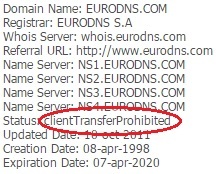Do you know what EPP status codes are? You cannot be serious!

Jeepers creepers, they can stop your domain name being hijacked and you don't know what they are? They're codes that tell you what’s going on. Is your registration about to fail? Is your name being transferred to another registrar? Is it going to be deleted? EPP status codes are alerts that gives you time to act...
Protect your domain names
Okay, this is a post you may want to save. It is a useful point of reference and could save you losing your domain names to hijackers.
Oh and my choice of image? I struggled to find something relevant and then it came to me, BATS - of course!
EPP status codes
Every domain name has at least one EPP status code (Extensible Provisioning Protocol), or domain name status code, sometimes more. It’s vital you know what they mean because they show the status of your domain name. Why it’s stopped working, is it safely locked, when it will expire, if a transfer is being processed. They can warn you about unauthorised deletions, transfers, renewals, and updates. Giving you time to protect your domain name from hijackers.
I’m going to give you the meaning and the action. Some just let you know what’s going on, whilst others are warnings and you need to act quickly.
EPP status codes – server & client
There are two types of EPP status code: client and server. Both codes show up in a WHOIS search, or on your registrar’s website.

- Server status codes – are set by the registries. They take precedence over the client status codes.
- Client status codes – are set by registrars (like EuroDNS). Some are activated automatically, others when you make a request.
Table 1 - Server and RGP (Registry Grace Period) status codes
| Status Code | Meaning | Action required |
| addPeriod | Grace period after registration. If a registrar deletes the name during this period, the registry MAY credit the registrar the cost of registration. | No issue with domain name, no action required. |
| autoRenewPeriod | Grace period after a domain name expires and is automatically renewed by the registry. If the registrar deletes the name during this period, the registry credits the registrar the cost of renewal. | Set for a limited time following automatic renewal of domain name. If you don’t want the name, you should contact your registrar. |
| inactive | Status code indicating the domain name has no delegated name servers. The domain name is not activated in the DNS and won’t resolve. | If this status doesn’t change, you should ask your registrar why processing is delayed. You may be asked to provide documentation as per the registration requirements. |
| OK | Standard status after registration. No pending actions and the name can be updated, transferred or renewed by the registrar. | Asking your registrar to enable clientTransferProhibited, clientDeleteProhibited, and clientUpdateProhibited, will keep your domain name safe. |
| pendingCreate | Status code indicating that a domain name request has been received and is being processed. | If the domain name is in a special registration period (e.g. Sunrise), this status may indicate that the name will be allocated at the end of that period. If the domain name is not in a special registration period and you are NOT the registrant, you should contact your registrar immediately. |
| pendingDelete | Status code indicating that your domain name has been in redemptionPeriod status for 30 days and you haven't restored it. The name will remain in this status for five more days, before being deleted from the registry database. It can then be registered by anyone. | If you see this status you should contact your registrar immediately, or you may lose your domain name. |
| pendingRenew | Status code indicating that a domain name renewal request has been received and is being processed. | If you see this status and you didn’t request renewal of your domain name, you should contact your registrar immediately. |
| pendingRestore | Status code indicating that your registrar has asked the registry to restore your domain name from the redemptionPeriod. The domain name will remain in this status for seven days, whilst the registrar provides confirmation of the restoration request. Failure to provide confirmation will return the domain name to redemptionPeriod. | Keep an eye on your domain name during the seven days. Your registrar has to submit the required documentation for restoration. If the deadline is missed and your name is returned to its redemptionPeriod, contact your registrar to find out what caused the delay. |
| pendingTransfer | Status code indicating that a domain name transfer request has been received and is being processed. | If you see this status and you didn’t request a transfer, you should contact your registrar immediately to stop the transfer. |
| pendingUpdate | Status code indicating that a domain name update request has been received and is being processed. | If you see this status and you didn’t request an update, you should contact your registrar immediately to stop the update. |
| redemptionPeriod | Status code indicating that your registrar has asked the registry to delete your domain name. It will remain in this status for 30 days. Five days after this period, your domain name will be deleted from the registry database. The domain name can then be registered by anyone. | If you see this status you should contact your registrar immediately to find out why your registrar has asked for your domain name to be deleted. Once the situation has been resolved, the domain name will be restored for you. |
| renewPeriod | Grace period after a domain name has been renewed by the registrar. If the registrar deletes the name during this period, the registry credits the registrar the cost of renewal. | This status indicates that your domain name was renewed by your registrar. If you didn’t ask for the renewal and you don’t want to keep the name, you should contact your registrar immediately. |
| serverDeleteProhibited | Status code preventing your domain name from being deleted. Usually used at your request during legal disputes, or when a redemptionPeriod status has been set. | This status may indicate an issue with your domain name. You should contact your registrar immediately. If there is no issue and you’d like to delete it, you need to contact your registrar and ask that it contact the registry to remove the status. |
| hold/serverHold | Status code set by the domain registry. Domain names in this status are not active in the DNS. | If you provided delegation information (name servers), this status can indicate an issue that has to be solved. You should contact your registrar. If there is no issue, but you’d like to resolve in the DNS, contact your registrar and provide the required delegation information. |
| serverRenewProhibited | Status code indicating that the domain registry will not allow your registrar to renew your domain name. Usually used during legal disputes, or when you domain name is to be deleted. | This status can indicate an issue that needs to be addressed, so contact your registrar immediately. If there is no issue and you’d like to renew it, you need to contact your registrar and ask that it contact the registry, to remove this status. |
| serverTransferProhibited | Status code preventing your domain name from being transferred from your current registrar. Usually used at your request during legal or other disputes, or when a redemptionPeriod status has been set. | This status can indicate an issue that needs to be addressed, so contact your registrar immediately. If there is no issue and you’d like to transfer it, you need to contact your registrar and ask that it contact the registry, to remove this status. |
| serverUpdateProhibited | Status code locking your domain name and preventing it from being updated. Usually used at your request during legal or other disputes, or when a redemptionPeriod status has been set. | This status can indicate an issue that needs to be addressed, so contact your registrar immediately. If there is no issue and you’d like to update it, you need to contact your registrar and ask that it contact the registry, to remove this status. |
| transferPeriod | Grace period after the successful transfer of a domain name from one registrar to another. If the NEW registrar deletes the name during this period, the registry credits the registrar the cost of transfer. | This status indicates that your domain name was transferred to a new registrar. If you didn’t ask for the transfer you should contact your registrar immediately. |
Client status codes set by your registrar
| Status Code | Meaning | Action required |
| clientDeleteProhibited | Status code telling the domain registry to reject any requests to delete your domain name. | This status indicates that your domain name can’t be deleted. It protects against hijacking and fraud. If you’d like to delete the name, you need to contact your registrar and ask that it remove this status. |
| clientHold | Status code telling the domain registry not to activate your domain name in the DNS, so it will not resolve. Usually used during legal disputes, non-payment or when your domain name is about to be deleted. | This status can highlight an issue with your domain name. If there are no issues and you’d like the domain name to resolve, you need to contact your registrar and ask that it remove this status. |
| clientRenewProhibited | Status code telling the domain registry to reject any requests to renew your domain name. Usually used during legal disputes or when your domain name is about to be deleted. | This status can highlight an issue with your domain name. If there are no issues and you’d like the domain name to renew, you need to contact your registrar and ask that it remove this status. |
| clientTransferProhibited | Status code telling the domain registry to reject any requests to transfer your domain name from your current registrar to another. | This status indicates that your domain name can’t be transferred, it protects against hijacking and fraud. If you would like to transfer the name, you need to contact your registrar and ask that it remove this status. |
| clientUpdateProhibited | Status code telling the domain registry to reject any requests to update your domain name. | This status indicates that your domain name can’t be updated, it protects against unauthorised and fraudulent updates. If you would like to update the name, you need to contact your registrar and ask that it remove this status. |
Registry - company maintaining administrative data of domain extensions, e.g. EURid is the registry looking after the .EU domain extension.
Registrar - company providing domain name registration services to customers, e.g. EuroDNS.
DNS (Domain Name System) - domain names are for humans, IP addresses are for computers. The DNS translates domain names into IP addresses so your computer understands.
I know, it's a lot to take in; it's real useful stuff though. If you've got any questions, please don't hesitate to get in touch.
